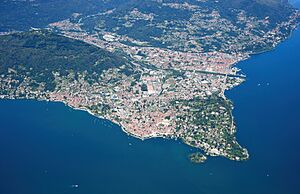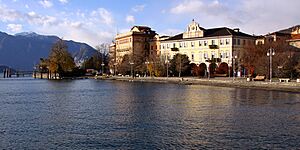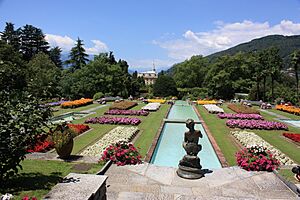Verbania facts for kids
Quick facts for kids
Verbania
|
||
|---|---|---|
| Città di Verbania | ||

Aerial view of Verbania from the south
|
||
|
||
| Country | Italy | |
| Region | Piedmont | |
| Province | Verbano-Cusio-Ossola (VB) | |
| Frazioni | Antoliva, Bieno, Biganzolo, Cavandone, Fondotoce, Intra, Pallanza, Possaccio, Suna, Tre Pomti, Torchiedo, Trobaso, Zoverallo | |
| Area | ||
| • Total | 37.49 km2 (14.47 sq mi) | |
| Highest elevation | 678 m (2,224 ft) | |
| Lowest elevation | 200 m (700 ft) | |
| Population
(1 January 2021)
|
||
| • Total | 30,104 | |
| • Density | 802.99/km2 (2,079.73/sq mi) | |
| Demonym(s) | Verbanese(i) | |
| Time zone | UTC+1 (CET) | |
| • Summer (DST) | UTC+2 (CEST) | |
| Postal code |
28900, 28921-28925
|
|
| Dialing code | 0323 | |
| Patron saint | Victor Maurus | |
| Saint day | 8 May | |
Verbania is a city in northwest Italy. It's the biggest town and capital of the province of Verbano-Cusio-Ossola. You can find it in the Piedmont region, right on the shore of Lake Maggiore.
Verbania is about 91 kilometers (56 miles) northwest of Milan. It's also about 40 kilometers (25 miles) from Locarno in Switzerland. In 2017, about 30,827 people lived there.
Contents
History of Verbania
People have lived in the Verbania area for a very long time, even before recorded history. The first known group was called the Lepontii. Around the first century AD, the Roman Empire, led by Emperor Augustus, took control of the area.
In the 11th century, bishops from Novara ruled the area. Later, the counts of Pombia took over. In 1152, Federico Barbarossa gave the land to the Castello family. After he died, Novara gained control again.
By the 14th century, Verbania became part of the Duchy of Milan. In 1714, after a treaty, much of the lake area came under the rule of the Habsburgs. Then, in 1796, Napoleon's French army invaded and controlled the area.
By 1818, the House of Savoy (an Italian royal family) took control back from the French. In 1836, Pallanza and Ossola became part of the province of Novara. After World War II, the area stayed part of Novara province. In 1976, the special district of Verbano-Cusio-Ossola was created.
About Verbania
Verbania is across Lake Maggiore from the city of Stresa. It's about 3.7 kilometers (2.3 miles) by water and 16 kilometers (10 miles) by road. The Verbania we know today was formed in 1939. This happened when the towns of Intra and Pallanza joined together.
Since 1992, Verbania has been the capital city of the Verbano-Cusio-Ossola province. There's a small island near Pallanza called the Isolino di San Giovanni. It's famous because the conductor Arturo Toscanini lived there from 1927 to 1952.
Verbania includes several smaller areas, or frazioni. These are like neighborhoods or small villages within the main city. Some of them are Intra, Pallanza, Suna, and Fondotoce.
Climate
Verbania has a mild and humid climate. Summers are warm, and winters are cold. The weather is influenced by the lake and the nearby mountains.
Main Sights to See
One of the main attractions is the Giardini Botanici Villa Taranto. This is a beautiful estate with amazing botanical gardens. You can see many different kinds of plants and flowers there.
Getting Around Verbania
The Verbania-Pallanza railway station opened in 1905. It's part of the train line that goes from Milan to Domodossola. The station is in the Fondotoce area, between Lake Mergozzo and the Toce river. A bus connects Verbania to this train station.
Verbania's International Connections
Verbania is "twinned" with several cities around the world. This means they have a special friendship and often exchange visitors or ideas.
Twin Towns and Sister Cities
 Bourg-de-Péage, France
Bourg-de-Péage, France Crikvenica, Croatia
Crikvenica, Croatia East Grinstead, United Kingdom
East Grinstead, United Kingdom Mindelheim, Germany
Mindelheim, Germany Sant Feliu de Guíxols, Spain
Sant Feliu de Guíxols, Spain Schwaz, Austria
Schwaz, Austria Piatra Neamț, Romania
Piatra Neamț, Romania Hendersonville, North Carolina, USA
Hendersonville, North Carolina, USA
Famous People from Verbania
Many notable people have connections to Verbania:
- Beniamino Bonomi (born 1968), a canoeist.
- Emanuela Brizio (born 1968), a mountain runner.
- Luigi Cadorna (1850–1928), a Field Marshal during World War I.
- Raffaele Cadorna, Jr. (1889–1973), a general.
- Filippo Ganna (born 1996), a cyclist.
- Wilfried Gnonto (born 2003), a footballer.
- Elisa Longo Borghini (born 1991), a cyclist.
- Emma Morano (1899–2017), who was once the world's oldest living person.
- Angelo Pagotto (born 1973), a footballer.
- Daniele Ranzoni (1843-1889), an artist.
- Bernhard Riemann (1826–1866), a mathematician.
See also
 In Spanish: Verbania para niños
In Spanish: Verbania para niños





